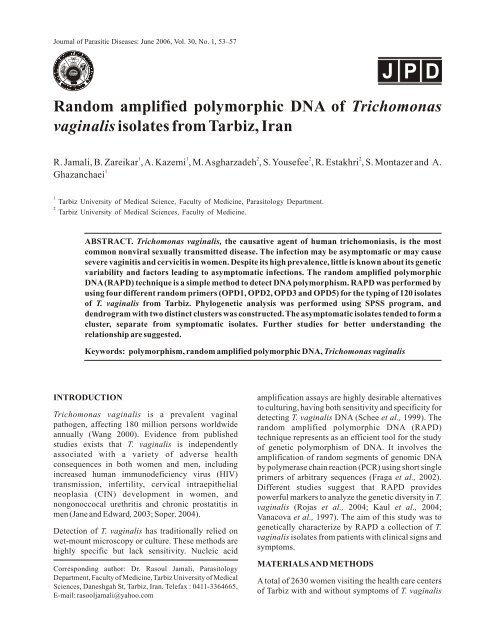PDF File - The Indian Society for Parasitology
PDF File - The Indian Society for Parasitology
PDF File - The Indian Society for Parasitology
You also want an ePaper? Increase the reach of your titles
YUMPU automatically turns print PDFs into web optimized ePapers that Google loves.
Journal of Parasitic Diseases: June 2006, Vol. 30, No. 1, 53–57J P DRandom amplified polymorphic DNA of Trichomonasvaginalis isolates from Tarbiz, Iran1 1 2 2 2R. Jamali, B. Zareikar , A. Kazemi , M. Asgharzadeh , S. Yousefee , R. Estakhri , S. Montazer and A.1Ghazanchaei12Tarbiz University of Medical Science, Faculty of Medicine, <strong>Parasitology</strong> Department.Tarbiz University of Medical Sciences, Faculty of Medicine.ABSTRACT. Trichomonas vaginalis, the causative agent of human trichomoniasis, is the mostcommon nonviral sexually transmitted disease. <strong>The</strong> infection may be asymptomatic or may causesevere vaginitis and cervicitis in women. Despite its high prevalence, little is known about its geneticvariability and factors leading to asymptomatic infections. <strong>The</strong> random amplified polymorphicDNA (RAPD) technique is a simple method to detect DNA polymorphism. RAPD was per<strong>for</strong>med byusing four different random primers (OPD1, OPD2, OPD3 and OPD5) <strong>for</strong> the typing of 120 isolatesof T. vaginalis from Tarbiz. Phylogenetic analysis was per<strong>for</strong>med using SPSS program, anddendrogram with two distinct clusters was constructed. <strong>The</strong> asymptomatic isolates tended to <strong>for</strong>m acluster, separate from symptomatic isolates. Further studies <strong>for</strong> better understanding therelationship are suggested.Keywords: polymorphism, random amplified polymorphic DNA, Trichomonas vaginalisINTRODUCTIONamplification assays are highly desirable alternativesto culturing, having both sensitivity and specificity <strong>for</strong>Trichomonas vaginalis is a prevalent vaginal detecting T. vaginalis DNA (Schee et al., 1999). <strong>The</strong>pathogen, affecting 180 million persons worldwide random amplified polymorphic DNA (RAPD)annually (Wang 2000). Evidence from published technique represents as an efficient tool <strong>for</strong> the studystudies exists that T. vaginalis is independently of genetic polymorphism of DNA. It involves theassociated with a variety of adverse health amplification of random segments of genomic DNAconsequences in both women and men, including by polymerase chain reaction (PCR) using short singleincreased human immunodeficiency virus (HIV) primers of arbitrary sequences (Fraga et al., 2002).transmission, infertility, cervical intraepithelial Different studies suggest that RAPD providesneoplasia (CIN) development in women, and powerful markers to analyze the genetic diversity in T.nongonoccocal urethritis and chronic prostatitis in vaginalis (Rojas et al., 2004; Kaul et al., 2004;men (Jane and Edward, 2003; Soper, 2004).Vanacova et al., 1997). <strong>The</strong> aim of this study was toDetection of T. vaginalis has traditionally relied ongenetically characterize by RAPD a collection of T.wet-mount microscopy or culture. <strong>The</strong>se methods arevaginalis isolates from patients with clinical signs andhighly specific but lack sensitivity. Nucleic acidsymptoms.Corresponding author: Dr. Rasoul Jamali, <strong>Parasitology</strong>Department, Faculty of Medicine, Tarbiz University of MedicalSciences, Daneshgah St, Tarbiz, Iran. Telefax : 0411-3364665,E-mail: rasooljamali@yahoo.comMATERIALS AND METHODSA total of 2630 women visiting the health care centersof Tarbiz with and without symptoms of T. vaginalis










